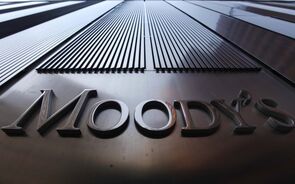Nichols de August 20, 2003
1 Mensagem
|Página 1 de 1
Nichols de August 20, 2003
Deixem-me só sublinhar a conclusão retirada por ele próprio, sobretudo depois da leitura do sentimento.
That said, the higher probability now is for a pullback that would rouse some fear.
WEDNESDAY a.m.
August 20, 2003
Post-Bubble Similarities
by David Nichols
For a while now, I've been pointing out the uncanny similarities between our "anti-bubble" and the pattern of price movement in the Nikkei's post-bubble at this same point, as measured from the peak of both markets. There's just an undeniable similarity to the charts.
But we should discuss what this does/doesn't mean, because this has really hit a resonant chord with people. I am getting asked a lot where a person can obtain a Nikkei chart, so a daily, blow-by-blow comparison can be made. Frankly, I think that's just the wrong way to look at this.
It's just a guide; a road-map for what the aftermath of a bubble can look like. There is never going to be a strict, pre-determined path for the markets to follow, as chaos is ever-present, lurking in the shadows, ready to apply an unexpected energy bolt to the emotions of traders without prior notice. When and how these chaotic effects are unleashed is inherently unpredictable, and it will always be thus.
For me, this Nikkei comparison underscores what can happen to markets during bubble/post-bubble periods. Herding and cooperative behavior among market participants becomes the dominant force, as very few really know how to make heads or tails of such a market beast. People react to a constantly evolving consensus opinion in rolling waves, based on how price is responding to that consensus opinion. Some in the herd react early, and others react more slowly, based on how much evidence -- in terms of rising or falling prices -- each distinctive market opinion requires to be changed.
Unfortunately for most market participants, their opinion only changes at the extreme tops and bottoms. At the tops, people are rah-rah-sis-boom-bah bullish, and at the bottoms most are mired in a strange mixture of fear and denial, which leads to a climactic gut-wrenching urge to cough up all market exposure.
This also brings up why a sentiment indicator like the Volatility Index (VIX) can be so valuable during a post-bubble period. It's a great way of measuring the sentiment of the herd, in a quantifiable way. It's also a unique indicator in that it is anti-persistent -- with a Hurst exponent less than .50, for all you nerds -- meaning it doesn't trend but rather oscillates back and forth in a predictable way. Well, fairly predictable would be more accurate.
The current drifty-to-lower VIX is uncharacteristic, but this sort of herd behavior is often seen at important tops. The market is lulling participants to sleep in a nice, dozy bullish haze, before dropping the whammy unexpectedly.
Indeed, this current August reminds me so much of August 2000, which was really the last hurrah of the upside bubble market. During that August, the fireworks of the early spring were forgotten, and the market managed to grind higher on low volume while the VIX stayed low. This was the direct prelude to the massive bear market wipeout that started right after Labor day in September 2000.

Right now our sentiment tank has hit zero. At no other point over the past year has sentiment been this bullish. That's a big, giant, waving red flag that this market is dangerous. Others may be bullish here -- and that certainly hasn't been wrong (but it hasn't been right, either, for over 2 months) -- but that makes the situation even more dangerous.
The time to be bullish is when the tank is full, and there is plenty of negative sentiment built-up to sustain a long advance. That's the only risk/reward profile that consistently works.
Also keep in mind that shorting a market with the VIX in the teens works pretty darn well, in either a bull or bear market. Yesterday's close on the VIX came at 19.23.
Sentiment Dashboard
by Adam Oliensis

SENTIMENT TANK: Drained to 0% full of negative sentiment on Tuesday. The tank is now expressing less negative sentiment (more positive) than at any time during the past year.
SHORT-TERM: Hourly gauge moved to neutral with a positive bias, regressing from a full-on advance phase.
MID-TERM: Progressed 10 points to 69% on the advance side of the gauge with an unchanged confidence level of a bullish 2 (out of 7).
LONG-TERM: Weekly gauge remains locked at a neutral 93/7 also with an unchanged confidence level of a bullish 2.
BOTTOM LINE: With the tank at 0% the mid-term gauge may very well roll over into a decline phase before moving up and over the yellow box (between 25 & 75) in which it has been caught since mid June. If this gauge is able to break out over 75% with NO FUEL in the tank, then that will likely come with a breakout over SPX 1015. Should this scenario obtain and not be very quickly reneged upon (by a collapse back below 1000-1006), that would suggest that the Greenspan Liquidity Gambit had incited the market into another rally leg.
That kind of event, again with the tank at 0%, with the VIX under 20, COULD (COULD COULD) represent a total capitulation by the bears. And that kind of capitulation event could be a really wicked spike to the upside, mirroring the kinds of capitulation spikes we normally see to the downside. A market that can CONTINUE to advance with the tank at 0% is deviating from its behavior of the prior year, and would either be redrawing the rules (as it did after Desert Storm in '91) or setting up a blowoff top of major proportions.
That said, the higher probability now is for a pullback that would rouse some fear.
That said, the higher probability now is for a pullback that would rouse some fear.
WEDNESDAY a.m.
August 20, 2003
Post-Bubble Similarities
by David Nichols
For a while now, I've been pointing out the uncanny similarities between our "anti-bubble" and the pattern of price movement in the Nikkei's post-bubble at this same point, as measured from the peak of both markets. There's just an undeniable similarity to the charts.
But we should discuss what this does/doesn't mean, because this has really hit a resonant chord with people. I am getting asked a lot where a person can obtain a Nikkei chart, so a daily, blow-by-blow comparison can be made. Frankly, I think that's just the wrong way to look at this.
It's just a guide; a road-map for what the aftermath of a bubble can look like. There is never going to be a strict, pre-determined path for the markets to follow, as chaos is ever-present, lurking in the shadows, ready to apply an unexpected energy bolt to the emotions of traders without prior notice. When and how these chaotic effects are unleashed is inherently unpredictable, and it will always be thus.
For me, this Nikkei comparison underscores what can happen to markets during bubble/post-bubble periods. Herding and cooperative behavior among market participants becomes the dominant force, as very few really know how to make heads or tails of such a market beast. People react to a constantly evolving consensus opinion in rolling waves, based on how price is responding to that consensus opinion. Some in the herd react early, and others react more slowly, based on how much evidence -- in terms of rising or falling prices -- each distinctive market opinion requires to be changed.
Unfortunately for most market participants, their opinion only changes at the extreme tops and bottoms. At the tops, people are rah-rah-sis-boom-bah bullish, and at the bottoms most are mired in a strange mixture of fear and denial, which leads to a climactic gut-wrenching urge to cough up all market exposure.
This also brings up why a sentiment indicator like the Volatility Index (VIX) can be so valuable during a post-bubble period. It's a great way of measuring the sentiment of the herd, in a quantifiable way. It's also a unique indicator in that it is anti-persistent -- with a Hurst exponent less than .50, for all you nerds -- meaning it doesn't trend but rather oscillates back and forth in a predictable way. Well, fairly predictable would be more accurate.
The current drifty-to-lower VIX is uncharacteristic, but this sort of herd behavior is often seen at important tops. The market is lulling participants to sleep in a nice, dozy bullish haze, before dropping the whammy unexpectedly.
Indeed, this current August reminds me so much of August 2000, which was really the last hurrah of the upside bubble market. During that August, the fireworks of the early spring were forgotten, and the market managed to grind higher on low volume while the VIX stayed low. This was the direct prelude to the massive bear market wipeout that started right after Labor day in September 2000.

Right now our sentiment tank has hit zero. At no other point over the past year has sentiment been this bullish. That's a big, giant, waving red flag that this market is dangerous. Others may be bullish here -- and that certainly hasn't been wrong (but it hasn't been right, either, for over 2 months) -- but that makes the situation even more dangerous.
The time to be bullish is when the tank is full, and there is plenty of negative sentiment built-up to sustain a long advance. That's the only risk/reward profile that consistently works.
Also keep in mind that shorting a market with the VIX in the teens works pretty darn well, in either a bull or bear market. Yesterday's close on the VIX came at 19.23.
Sentiment Dashboard
by Adam Oliensis

SENTIMENT TANK: Drained to 0% full of negative sentiment on Tuesday. The tank is now expressing less negative sentiment (more positive) than at any time during the past year.
SHORT-TERM: Hourly gauge moved to neutral with a positive bias, regressing from a full-on advance phase.
MID-TERM: Progressed 10 points to 69% on the advance side of the gauge with an unchanged confidence level of a bullish 2 (out of 7).
LONG-TERM: Weekly gauge remains locked at a neutral 93/7 also with an unchanged confidence level of a bullish 2.
BOTTOM LINE: With the tank at 0% the mid-term gauge may very well roll over into a decline phase before moving up and over the yellow box (between 25 & 75) in which it has been caught since mid June. If this gauge is able to break out over 75% with NO FUEL in the tank, then that will likely come with a breakout over SPX 1015. Should this scenario obtain and not be very quickly reneged upon (by a collapse back below 1000-1006), that would suggest that the Greenspan Liquidity Gambit had incited the market into another rally leg.
That kind of event, again with the tank at 0%, with the VIX under 20, COULD (COULD COULD) represent a total capitulation by the bears. And that kind of capitulation event could be a really wicked spike to the upside, mirroring the kinds of capitulation spikes we normally see to the downside. A market that can CONTINUE to advance with the tank at 0% is deviating from its behavior of the prior year, and would either be redrawing the rules (as it did after Desert Storm in '91) or setting up a blowoff top of major proportions.
That said, the higher probability now is for a pullback that would rouse some fear.
1 Mensagem
|Página 1 de 1
Quem está ligado:
Utilizadores a ver este Fórum: Bing [Bot], Google Adsense [Bot], Lisboa_Casino, m-m, navaldoc e 131 visitantes



